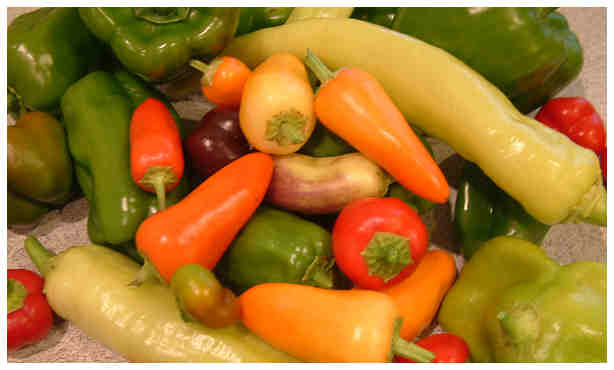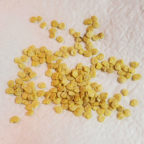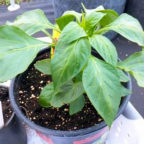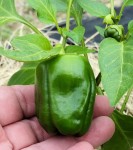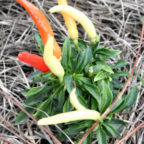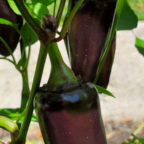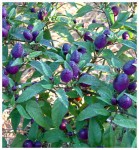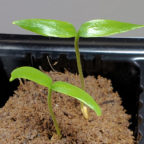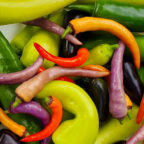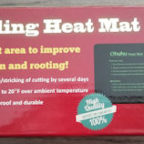Pepper Plants and Seeds
Pepper plants and seeds are fun to work with (as you probably already know). So today is an update on the peppers and chiles that I have on deck — plants and seeds.
Bell Pepper, Yellow
This is a plant that I bought, with hopes of getting some more bells. As you’ll remember in some of my growing peppers in Florida posts, I traditionally have a hard time with bell peppers. This time I decided to just buy a plant and hope for the best.
It’s doing fairly well, and some blossoms are getting ready to appear — at least six so far. I’d have liked the plant to be a little larger, but I’ll see what happens. The size may have something to do with the fact that it’s been cooler than normal these last few weeks — days in the 60’s to low 70’s, nights in the 40’s.
Sweet Banana Peppers
The next on deck and growing well are the Sweet Banana peppers. I love the sweet bananas, and they are still a way from planting out in the garden, but they’ve been doing well, in spite of the cooler weather (I have them outdoors in a protected location).
Redskin Bell
Redskin, a bell with a “weeping” habit, is doing well. I figured I’d try another kind of bell, and grow it out on the screened patio in a pot, see what happens.
Purira Chile Pepper
I love growing the hot peppers that look like Christmas trees, with candles of all kinds of colors. Purira is a pretty hot pepper with tons and tons of cone-shaped fruits. Colors vary between ivory, yellow, purple, orange and red, with all colors appearing at any given time. Ornamental, but drop one small ripe pepper in a pot of chile and watch out!
Pretty in Purple Pepper (Hot)
Pretty in Purple is one is another of the ornamental but hot peppers. The leaves and stems are mostly purple, and the peppers are purple, ripening to red hot red. Put one or two in your chili for a nice heat.
Sweet Pickle
Name notwithstanding, I like to eat these Sweet Pickle peppers fresh. Kind of remind me of the Purira chile, with a Christmas tree appearance. These are great sliced up in salads, soups and salsa. Not hot at all — just sweet. One of these days I’ll have to try pickling them.
The Really Hot Chiles
My bhut jolokia has arrived, and I’m waiting for the mustard habaneros to show up. Thai hot, peter pepper, datil and hot-banero are also waiting in the wings. Hot-banero is the hottest habanero I’ve ever grown (my own strain), and I want to see how it stacks up against jolokia and the mustard habanero.
I’m not in a super-hurry for the really hot peppers; they like the warmth and it’s still pretty cool. In my experience, the hotter the pepper, the warmer the soil it needs to germinate, and the longer it takes to germinate. I don’t plan on putting any of the really hot chiles out in the garden until maybe the beginning of March.
But I will very shortly be germinating some jalapeno seeds — Jalapeno M variety. Debating on trying the Jaloro as well; those are some of my legacy (i.e. 10-year-old) seeds. Germination for the older seeds has been kind of low, but we’ll see what happens. Jaloro is a yellow jalapeno, instead of the usual green. But I like to use it red, which gives it a really nice kick.
Growing Peppers in Containers
Growing peppers in containers is easy, and most (if not all) peppers will thrive. In fact, some were selected for their ability to grow well in a pot! Let’s look at some things to consider when growing your peppers in a container.
Choose the Proper Size Pot
It’s not so much a problem with the pot being too big, but rather don’t go choosing one too small. Although many peppers don’t grow to more than 20″ tall, they still need enough room for their roots to spread out.
For the smaller peppers (under 12 ” tall), you’ll need a 2 gallon container. For the larger pepper plants, a 5 gallon or even 10 gallon container will give the peppers plenty of room to grow. Not sure what you need? Try a 3-gallon container and a good soil mixture with plenty of nutrients.
Oh, and remember — your container needs to have drainage holes, so excess water has a way to escape.
What Kind of Soil to Use
I prefer to use bagged soil, seeing as the soil in my yard is fairly sandy. I like a mixture of composted cow manure and organic potting soil. The composted cow manure feeds the plants, and the organic potting soil lets the plant’s roots grow freely. I generally use in a 50/50 ratio (just as much composted cow manure as potting soil).
I generally avoid any potting soil labeled as “african violet” or “houseplant” or any such designation. I also like to avoid pre-fertilized potting soil. If you can’t find any “regular” potting soil, try using sphagnum moss instead, at a ration of 40/60 (40% sphagnum and 60% composted cow manure). Here’s some more information on the kind of soil peppers like.
If you have access to real compost (meaning, from your own compost pile), by all means use that! Just make sure it’s fully “cooked” to destroy any lingering unfriendly bacteria or fungi.
Feeding and Watering
Your pepper plants will very likely need more frequent watering when being grown in a container, as well as more frequent fertilizing.
Watering should be done whenever you can stick your finger 1 inch into the soil and it’s dry (the tried and true method). Soon enough, you’ll get to recognize whether that means watering every day, every other day, etc. for your particular growing conditions.
I like to use my fertilizer at no more than 1/2 strength, but I fertilize a little more often — usually once every other week. When your pepper is first growing, it needs a fair amount of nitrogen, but once it starts producing flowers, it needs more phosphorus. I prefer doing things as organically as possible, so I like worm castings, fish emulsion and seaweed extract. (See the organic fertilizer and peppers post for more information.)
If I feel the plant needs a little boost of nitrogen or phosphorus (beyond the normal fertilizing), I’ll add in some blood meal (nitrogen) or bone meal (phosphorus). Both can be found in most garden centers.
I am debating adding an organic tomato fertilizer to this mix — after all, tomatoes and peppers are related and have similar requirements.
Staking or Caging
Some peppers may need to be staked or caged due to their growing habits. I usually find that bell peppers need to be staked, due to fruit weight. Large rangey plants like jalapenos may need to be caged if they start overtaking your container gardening area.
Ultimately, it’s up to you, especially since there are now peppers like Mohawk that are more of a draping/hanging pepper, instead of upright.
Those Really Hot Chile Peppers
Please keep in mind that if you decide to grow the really, really hot chile peppers (like scotch bonnet, habaneros, etc.), please don’t do it around small children or pets. Just touching the fruit of these plants can cause severe irritation and burning.
I also would recommend staking or at least caging such chile peppers, if they are in an area where people will potentially be walking near them. All you need to do is brush by the peppers to get the oil on your clothes/body.
And remember, when staking or caging the extra-hot chile peppers, please use rubber gloves — preferably the disposable kind. That’s a lesson I had to learn the hard way. (And naturally, also use the rubber gloves when harvesting the peppers.)
Growing Peppers in Containers is Easy!
That’s pretty much all you need to know about growing peppers in containers. This means that even if you don’t have a yard, you can have garden-fresh peppers. Just make sure that the spot where you plan to put the pots gets at least 8 hours of sun a day, and is in a warm spot (peppers like heat).
If you plan to grow your peppers from seeds, you may want to check out the growing peppers from seeds post. If your inclination is towards growing chile peppers, check out the growing chile peppers post.
Enjoy!
Growing Chile Peppers
So, is growing chile peppers any different than growing bell or sweet peppers? Overall growing is the same, but there are some special considerations for hot chile peppers. And the hotter the pepper, the more important these differences become.
What’s the Scoville Rating of the Pepper?
You should be aware of the Scoville rating of your chosen peppers. The what rating? If you’re not familiar with it, check out the about chile peppers post to find out about the Scoville scale. Then come back here and read on!
The reason you need to know about the general Scoville rating is that the higher the Scoville, the warmer the peppers like it! This includes everything from germination to growing weather.
I personally have noticed a difference in temperatures for germinating seeds for non-chile peppers versus the hot ones. And also within the peppers based on their heat. My sweet pepper seeds almost always germinate faster than the chiles. In fact, I’m seeing it right now, with the latest batch of seeds (sweet and chile) that I am germinating. So far, it’s just the sweet/bell peppers that have popped their head above soil.
So growing chile peppers starts with warmer germination temperatures. If you want information about a way to keep the growing medium warmer than usual, check out the growing peppers in Florida post.
Growing Chile Peppers – Containers or Garden?
Most chile peppers don’t grow terribly large, so are fine for growing in containers if that’s your wish. The peppers that seem to always grow larger for me are the jalapeno peppers, so if you grow them in a container, make it a larger container. When happy in the garden, I’ve had jalapenos grow over 4 feet tall. Let me tell you — that was a lot of jalapenos!
Now here’s something anecdotal. In my experience, the hotter the pepper, the shorter the pepper grows.  It doesn’t mean a shorter pepper isn’t just as prolific as the larger peppers, though. In fact, the very hot chile peppers like Bolivian Rainbow (which I grow for ornamental and eating purposes) bears smaller peppers but tons of them! But these peppers rarely grow more than about 20 inches tall.  This isn’t a hard and fast rule, though — there are some habaneros that can grow 3 feet tall.
I’ve just ordered some bhut jolokia seeds, which happens to be the hottest pepper in the word these days (1,000,000+ Scoville). So I’ll see if they need even warmer soil and weather conditions. And I’ll see how tall they grow, compared to my average-sized habaneros.
Chile Pepper Weather
Keep in mind that chile peppers originated in Central America, so you know they love hot weather. And interestingly, some hot peppers like habaneros and scotch bonnets can live as a perennial in a climate with warm weather year ’round.
The farther north you grow them, the more hours of direct sunlight your chile pepper plants need. (Here in South Florida in the summer, I make sure they get morning and afternoon sunlight, but have dappled shade mid-day; our sun is strong!)
So keep your chile pepper seeds warmer during germination (up to 95 degrees for the hottest peppers), although 85 tends to be the best overall temperature. Make sure you plant your peppers in a very warm area of your garden with plenty of sunshine, but which still has good air circulation. Give them some fertilizer (I prefer organic fertilizers) and keep the soil damp, but not wet.
Then, enjoy the harvest of your chile peppers!
